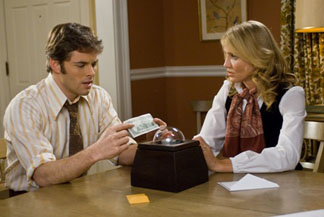Book vs. Movie: The Box
By Russ Bickerstaff
November 9, 2009
By contrast, the Lewises in the TV adaptation live in a small, one-bedroom apartment furnished with second-hand items that appear to be ten or more years old. Their car is falling apart. She's a chain-smoking housewife. He works the kind of job that requires a uniform and a nametag. The TV Lewises appear to be very working class. They are played by Mare Winningham and Brad Davis — two actors who had been largely known for TV work at the time of the show. Davis and Winningham have clearly been directed to perform an extreme exaggeration of human emotion. Winningham's Norma is bitter and abusive. Davis' Arthur seems simple and well meaning, but somewhat cold and aggressive. Director Peter Medak (Zorro, The Gay Blade, Romeo Is Bleeding) unrealistically amplifies tensions for the small screen in a way that ridiculously amplifies the mood into some surreal theater of abuse. It's a very surreal situation that they find themselves in, but it is firmly grounded in reality and Medak has done an excellent job of delivering on the surreal potential of it all.
Things don't get any less surreal when veteran TV actor Basil Hoffman enters the picture as Mr. Steward, the gentleman in charge of explaining the box to Norma. Though the printed story has both she and Arthur present when the gentleman comes by, the TV adaptation has Arthur at work at 8 p.m. when Mr. Seward visits, leaving Norma to confront him alone. Winningham plays strong indifference as the oddly dramatic Mr. Steward comes by to hand her the key and explain to her the situation. Press the button and someone you don't know dies. The major difference here is the sum. Rather than the $50,000 award for pressing the button in the printed story, the sum is raised here to $200,000. This accounts for inflation between 1970 and 1987 with an additional $3,400 or so, so we're talking about roughly the same amount of money, which would be considerably more to a blue collar single-income household in 1987.
At just under 20 minutes with opening and closing credits, the TV version's story plays out in a very similar fashion to the story, with Arthur coming across much more sympathetically than Norma. Arthur is concerned with Norma's obsession with the box. He's convinced that it's a sick joke and even unscrews the bottom panel to show her that there's no device inside the box. Finally, near the end of the episode, both sit mesmerized by the mystery of it all, staring deeply into the box. He finally suggests that she push the button just to be able to put it behind her. And she does.
The next morning Mr. Seward comes by to collect the box and deliver a briefcase with the money. When asked how he knew that they had pressed the button, Mr. Seward merely says, "Who wouldn't?" Asked what happens next, he says, "You spend the money." He goes on to say that the button unit will be taken back, "re-set and re-programmed (a bit odd for something that had no technology in it to begin with) and handed over to someone else. He informs them that the person who receives the box will be someone they don't know. Seward lets himself out. Cue the creepy music and a slow-dramatic close-up on the face of Winningham, slowly realizing the implications of what Seward just said.
Continued:
1
2
3
4
5
|
|
|
|




